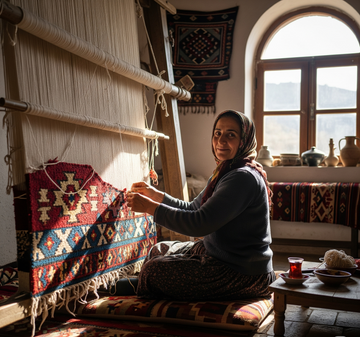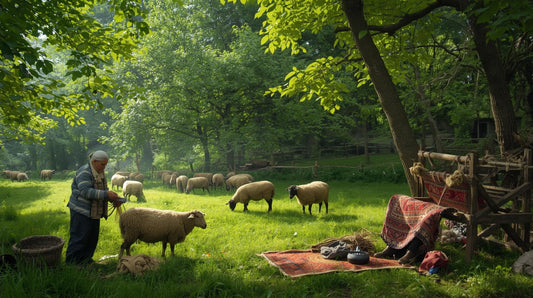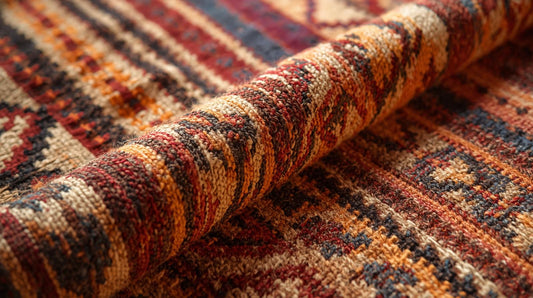Woven Legacies: How Influential Figures Shaped the Story of Turkish Carpets

Turkish rugs, celebrated for their exquisite craftsmanship, intricate designs, and vibrant colors, possess a history spanning millennia.1 Their origins can be traced back to the nomadic tribes of Central Asia, who carried their weaving traditions to Anatolia, the heart of modern-day Turkey.2 Over centuries, this ancient craft underwent significant transformations, absorbing diverse aesthetic influences from Persian, Byzantine, and Islamic art, which collectively contributed to the emergence of the distinctive "Anatolian rug".2 Beyond their inherent beauty and practical utility, Turkish carpets evolved to become potent symbols of wealth, social standing, and diplomatic prowess. Their journey across continents was profoundly shaped by the patronage, artistic vision, and economic ambitions of pivotal historical figures within both the Ottoman Empire and various European courts.
The significance of these textiles extended far beyond mere luxury. The acquisition and display of Turkish carpets served as a tangible manifestation of a nation's expanding economic power, its reach into distant markets, and its diplomatic standing in a competitive global arena. For instance, in early modern English drama, Turkish carpets symbolized not just opulence, but England's burgeoning ambition to establish its own global presence.4 The ability to command and integrate such exotic, high-value foreign luxuries into one's own cultural landscape was a subtle yet powerful form of geopolitical signaling, reflecting a nation's capacity to engage with and influence the wider world.
Ottoman Sultans: Patrons of Imperial Splendor
The Ottoman court played a central role in the evolution and dissemination of Turkish carpets, transforming carpet weaving into a highly developed art form. During the Islamic Golden Age, from the 8th to the 13th century, rug weaving flourished in Persia, Turkey, and Egypt, with designs heavily influenced by Islamic art and architecture.5 By the 15th century, the Ottoman Empire solidified its position as a major hub for rug production, with Ottoman carpets featuring bold, colorful designs often incorporating floral and animal motifs, deeply influenced by the empire's own art and architecture.5 The court workshops in Istanbul became pivotal to this artistic flourishing, employing the most highly skilled designers and weavers from across the empire.6
Ottoman sultans actively commissioned exceptionally fine "palace rugs" for their imperial residences and religious institutions. These court carpets, handwoven under the earlier sultans, often featured wool pile on silk or wool foundations, adorned with intricate floral patterns and circular medallions.8 Distinct from regional Anatolian rugs, these "palace rugs" frequently utilized the Iranian "sine" knot, and while initially influenced by Persian styles, they gradually developed a unique Anatolian character.3 Their designs often incorporated naturalist patterns depicting popular Ottoman art themes of the era, such as tulips, hyacinths, carnations, and pomegranate flowers.3 This active patronage by the sultans fostered a centralized, integrated design approach, ensuring a consistent, high-quality "court style" across various art forms, including ceramics, paintings, and textiles.6 This top-down control effectively "branded" the imperial aesthetic, elevating carpet weaving to a high art form and distinguishing court production from more localized or commercial workshops.
These luxurious carpets served as profound indicators of their owners' status and wealth.6 They were extensively used on the floors of reception halls, audience chambers, and at court-supported religious institutions.6 The finest examples were frequently presented as impressive diplomatic gifts to other rulers, showcasing the empire's immense wealth and artistic excellence.6 A notable illustration of this symbolic function is a painting commissioned by Sultan Murad III, which depicts a Safavid dignitary being presented to the Ottoman sultan against the backdrop of a magnificent red and blue Ushak medallion carpet.6 This visual arrangement vividly demonstrates how carpets functioned as decorative and symbolic backdrops for Ottoman court rituals, sending a clear message to political rivals like the Safavids about the immense wealth, cultural sophistication, and artistic accomplishments of the Ottoman court.6 Such displays were a form of "soft power," designed to project imperial might and cultural superiority without resorting to military force.
The Ottoman Empire's military expansion directly contributed to artistic innovation in carpet weaving. The "Carpet Design Revolution" that swept through Turkey by the late 15th century coincided with Ottoman conquests, including the capture of Tabriz in 1514 and Cairo in 1517.4 These conquests led to the integration of key Persian and Egyptian weaving techniques and, significantly, the relocation of skilled weavers from Tabriz to Istanbul.4 Furthermore, the unusual structure of S-spun wool found in Ottoman court carpets, typical only of Egyptian carpets, is directly attributed to the Ottoman conquest of Egypt in 1517, after which Egyptian weavers and wool were sent to Turkey for imperial use.6 This demonstrates that imperial expansion was not merely about territorial gain, but a strategic absorption of artistic and technical expertise from conquered regions, a deliberate policy that resulted in a richer, more sophisticated, and commercially appealing product.
A later development in imperial production was the establishment of the Hereke Imperial Factory in 1843 in Hereke, a coastal town near Istanbul. Initially, this workshop supplied royal palaces with silk brocades and other textiles.10 Carpet production specifically began in Hereke in 1891, with expert weavers recruited from renowned carpet weaving centers like Sivas, Manisa, and Ladik.10 In their early years, these handwoven carpets were exclusively made for the Ottoman palaces or served as prestigious gifts for visiting statesmen.10 Hereke carpets are renowned for their exceptionally fine weave, often using silk thread or fine wool yarn, with silk carpets boasting a density of 80-100 knots per square centimeter.10 The oldest Hereke carpets are now exhibited in Topkapi and other Istanbul palaces.10 This initiative represents a strategic, state-sponsored effort to industrialize and commercialize luxury production. The consolidation of talent and standardization of high-quality output not only met imperial demand and diplomatic needs but also successfully transformed a traditional craft into a globally recognized brand, where "Hereke carpet" became synonymous with a standard of quality, regardless of its precise origin.10
European Royalty and Aristocracy: Adorning Palaces and Asserting Power
As the Ottoman Empire expanded and its influence grew, the allure of Turkish carpets spread significantly across Europe. Early modern European aristocrats and royal figures, particularly in England, highly prized these imports for their exotic appeal.4 During the Renaissance, Turkish carpets captivated the artistic community, becoming powerful symbols of luxury and exoticism that adorned the opulent interiors depicted in many artworks of the period.11
English royalty and their advisors were prominent collectors and promoters of these prized textiles. Henry VIII and his influential advisor, Cardinal Wolsey, were avid collectors of what came to be known as "Holbein carpets," named after the artist Hans Holbein the Younger who famously depicted them in portraits like The Ambassadors (1533).4 While England initially produced embroidered rather than knotted carpets, these imitations underscored the strong domestic demand for Ottoman-inspired decor.4 Queen Elizabeth I's endorsement of trade with the Ottomans further facilitated this broader economic expansion, influencing both the English marketplace and the literary imagination for years to come.4 The fact that these carpets were renamed after European artists, such as Holbein, signifies a deep cultural integration and popularization of these foreign objects within European society, solidifying their status as coveted symbols among the Western elite.
In European paintings, especially from the 16th century, carpets were frequently depicted in portraits as a clear signifier of the sitter's sophistication, education, and high social and economic status.12 Interestingly, these valuable carpets were often draped over tables rather than placed on the floor, a practice that highlighted their immense value and status as art objects.6 This display method underscored their role as precious objects of wealth and connoisseurship, comparable to paintings and sculptures.13 This practice reveals a fundamental difference in how these items were valued and presented in elite European homes, elevating their status beyond mere utility.
The fascination with Turkish carpets also permeated English drama, with playwrights incorporating them into their works to evoke themes of power, prestige, and exotic wealth.4 In Christopher Marlowe's
Tamburlaine the Great, for instance, Callapine envisions streets lined with "Turkey carpets" as part of a grand display of power and luxury.4 This imagery conveyed a sense of dominance and grandeur, reflecting not only personal wealth but also an empire's power to acquire and display foreign luxuries. This would have resonated strongly with an English audience familiar with the Ottoman Empire's wealth and influence, as well as their own country's rising interest in trade with the East.4 Similarly, Ben Jonson's
Volpone includes a reference to "Turkey carpets" that underscores their association with wealth and prestige, serving as markers of Volpone's amassed fortune and used to create an image of opulence intended to deceive and manipulate.4
The Artists' Canvas: Immortalizing Turkish Carpets in Masterpieces
European paintings, particularly from the Renaissance onwards, serve as an indispensable primary source for the study of early carpets, providing invaluable visual records of their designs and usage.12 Artists such as Hans Holbein the Younger, Lorenzo Lotto, Domenico Ghirlandaio, Carlo Crivelli, and Hans Memling frequently incorporated Turkish carpets into their works.6 This artistic trend continued into the 17th century with prominent Dutch and Flemish painters like Johannes Vermeer, Jan Brueghel, Peter Paul Rubens, Nicolaes Maes, and Gerard ter Borch.12
So profound was the influence and consistent depiction of these textiles that many types of Islamic carpets from the Middle East are now named after the European painters who featured them.6 This practice of naming carpets after European artists, rather than their Ottoman or Anatolian origins, reflects a subtle yet powerful dynamic of cultural assimilation, where the identity of these objects was re-framed through a Western lens. This "Orientalist gaze," as seen in the 19th-century fascination with the East, integrated the carpets into European art historical narratives, making them more accessible and desirable within Western markets.
-
"Holbein Carpets": Named after Hans Holbein the Younger, these Ottoman carpets are characterized by purely geometric designs, featuring arrangements of lozenges, crosses, and octagonal motifs.6 Holbein famously depicted a Type III "Large-pattern Holbein" carpet draped over a table in
The Ambassadors (1533).4 Holbein often used carpets in portraits, typically on tables, but notably on the floor for Henry VIII.17
-
"Lotto Carpets": These hand-knotted Turkish carpets, primarily produced in the Ushak region of Anatolia 15, are named after the 16th-century Venetian painter Lorenzo Lotto. They are characterized by a lacy arabesque, usually in yellow on a red ground with blue details.6 They appear in paintings by Lotto (e.g.,
The Alms of St Anthony, 1542) and others like Jan Brueghel and Peter Paul Rubens (The Feast of Acheloüs).12
-
"Ghirlandaio Carpets": Named for the Italian Renaissance artist Domenico Ghirlandaio, these carpets, often from the Bergama region, display a central octagonal medallion inscribed within a square, with curvilinear designs emerging from its sides to form an overall diamond shape.6
-
"Crivelli Carpets": Named after the Italian Renaissance painter Carlo Crivelli, these rugs feature a large, complex star motif, as seen in his Annunciation paintings.6
-
"Memling Carpets": Named after the German painter Hans Memling, these carpets feature a distinctive motif characterized by hooked lines radiating from a central denticulate body, usually framed by a linear octagon, often called "Memling Guls".6 These carpets are believed to originate from Anatolia or Armenia.23
-
Johannes Vermeer: While Johannes Vermeer frequently included Oriental carpets in his intimate household scenes, often draped over tables 6, no specific carpet type was named after him. This may be attributed to his use of different Oriental carpets across his relatively small lifetime output, unlike other painters who consistently featured a single design.14
The depiction of Turkish carpets in European paintings was more than merely decorative; it served as a powerful visual signifier of the sitter's sophistication, education, and high social and economic status.12 These artworks also provide invaluable insights into the types, patterns, and usage of early carpets, making them a primary source for historical scholarship.12 They reflect a complex cultural exchange where Eastern artistry became deeply embedded in Western aesthetic sensibilities and social practices. This influence extended to shaping Western artistic and design principles over centuries, with their vibrant patterns and organic forms providing a new visual vocabulary that fundamentally shaped various art movements, from the Renaissance to Art Nouveau.11
A fascinating aspect of this artistic exchange is the reciprocal influence observed in the "Bellini Carpet" phenomenon. Gentile Bellini's paintings not only featured Islamic prayer rugs but also, in turn, inspired new designs in Persian and Turkish rugs, which subsequently became known as "Bellini carpets".25 This demonstrates a dynamic, two-way artistic dialogue, where Western artistic interpretations of Eastern designs could feedback into and stimulate new aesthetic developments within the original Eastern craft traditions.
European Artists and "Named" Turkish Carpets
| Artist Name | Associated Carpet Type | Key Characteristics/Motifs | Notable Painting(s) Featuring the Carpet | Origin Region (if specified) |
| Hans Holbein the Younger | Holbein Carpet | Geometric patterns, lozenges, crosses, octagonal motifs | The Ambassadors (1533) | Anatolia |
| Lorenzo Lotto | Lotto Carpet | Lacy arabesque, typically yellow on a red ground, blue details | The Alms of St Anthony (1542), The Feast of Acheloüs | Ushak, Anatolia |
| Domenico Ghirlandaio | Ghirlandaio Carpet | Central octagonal medallion within a square, curvilinear designs | (Various paintings) | Bergama |
| Carlo Crivelli | Crivelli Carpet | Large, complex star motif | Annunciation paintings | Anatolia |
| Hans Memling | Memling Carpet | Hooked lines radiating from a central denticulate body, linear octagon ("Memling Guls") | The Virgin and Child | Anatolia or Armenia |
Beyond Borders: Merchants, Trade Routes, and Cultural Exchange
The Silk Road, an extensive network of trade routes connecting Asia with North Africa and Europe for over 2,100 years, was a pivotal corridor for multifaceted interactions between East and West.26 While renowned for silk, carpets were also among the most significant artifacts traded along this route.26 This trade facilitated not only the exchange of goods but also a far greater exchange of ideas, cultures, textiles, crafts, arts, and technology.27 This emphasizes that carpets, as tangible objects, were not just economic commodities but also carriers of intangible cultural elements—designs, motifs, symbolic meanings, and weaving techniques. Their movement along the Silk Road fostered a profound cross-cultural diffusion of artistic ideas, influencing distant societies and contributing to a mutual enrichment of artistic traditions.
The intensive pace of carpet weaving and trade along the Silk Road significantly contributed to global trade relations and the expansion of transport routes.26 As Turkish carpets were exported to Europe from the 15th century onwards, their designs began to incorporate European elements such as coats of arms, cartouches, and other heraldic symbols, as well as European color preferences.5 This led to unique blends like the "Transylvanian" rugs, produced under Ottoman rule in present-day Romania, which uniquely combined Ottoman and European design elements.5 The widespread popularity of Oushak rugs, for instance, was so profound that "Ushak" became an English word of Turkic origin, reflecting their deep integration into European commerce and culture.15 This linguistic adoption is a powerful indicator of the significant cultural and commercial impact of these specific carpets, demonstrating a powerful "brand identity" that transcended geographical and temporal boundaries.
The 19th century witnessed the impact of the Industrial Revolution, leading to the mass production of carpets and the development of new synthetic dyes, which allowed for a wider range of colors and designs.5 While mass production made carpets more widely accessible to a broader European populace, it also posed a potential challenge to the unique craftsmanship and artistic value of traditional hand-knotted pieces. This creates a tension between widespread availability and the preservation of artisanal quality and authenticity, a recurring theme in the history of crafts in the face of industrialization.
The use of carpets in Europe also evolved, reflecting changing affordability and status. Early European paintings depicted carpets on tables as symbols of high status, but later, as seen in Francis Wheatley's 18th-century painting The Saithwaite Family, a large Ushak carpet is depicted as a floor covering.12 This shift occurred because carpets became more affordable in Europe.12 This illustrates a clear economic and social trend driven by increased trade volume and potentially more efficient production methods. As carpets transitioned from rare, precious imports to more accessible commodities, their functional use shifted from exclusive display items to more common floor coverings, indicating a democratization of luxury goods over time.
Within Turkish culture, rugs were an integral part of daily life, used for various purposes such as prayer, decoration, and even as dowry items.1 This multi-functionality—serving practical needs (warmth, comfort), spiritual purposes (prayer rugs providing a "sacred spot" for prayer 28), and social functions (dowry items, markers of family wealth)—underscores their deep cultural embeddedness within Turkish society. This versatility likely contributed to their widespread production and enduring appeal, both locally and internationally, making them more than just commodities but essential cultural artifacts.
The syncretic origins of Turkish carpet art are also noteworthy. Turkish rug weaving evolved by "incorporating influences from various cultures, including Persian, Byzantine, and Islamic art".2 This understanding highlights that Turkish carpet design is not a singular, isolated tradition but a rich synthesis of diverse artistic heritages. Anatolia's position as a historical crossroads allowed for the absorption and fusion of various aesthetic and technical elements, resulting in the unique and complex visual language of Turkish carpets.
Furthermore, the carpet weaving and trade industry had a significant impact on the development of global trade relations and transport routes.26 Carpets were not merely commodities traded
on existing routes; their high value and demand actively shaped and expanded these global trade networks, such as the Silk Road.26 The industry's contribution to "the parallel development of other industries such as sheep and camel farming" 26 demonstrates a broader economic ripple effect, positioning carpet production as a key driver of regional and international economic development. In some instances, high-quality textiles, including many Turkish carpets, were even used as a form of currency, highlighting their immense intrinsic value and liquidity in historical trade.27 This suggests that certain carpets functioned not merely as goods to be exchanged but as a medium of exchange and a store of wealth, akin to precious metals, elevating their economic significance beyond simple commodity status.
Conclusion: An Enduring Tapestry of Influence
The remarkable journey of Turkish carpets is a compelling testament to the profound and multifaceted impact of influential figures throughout history. Ottoman sultans, through their imperial patronage, not only fostered a distinct "court style" but also strategically integrated expertise from conquered regions, transforming carpets into powerful instruments of both cultural expression and diplomatic soft power. Their deliberate commissioning of exquisite "palace rugs" and the establishment of state-sponsored production centers like Hereke solidified the carpet's role as a symbol of imperial wealth and artistic excellence.
Concurrently, European royalty and aristocracy, driven by a desire for luxury and global prestige, fueled a robust demand for these exotic imports. Figures like Henry VIII, Cardinal Wolsey, and Queen Elizabeth I actively collected and promoted Turkish carpets, integrating them into their courts and literature, and elevating them to symbols of status and sophistication. The practice of displaying these valuable textiles on tables, rather than on the floor, further underscored their redefinition as precious art objects within European society.
Moreover, renowned artists of the Renaissance and later periods immortalized these textiles in their masterpieces, inadvertently shaping their nomenclature and integrating them deeply into the Western art historical canon. The naming of entire carpet types after European painters, such as "Holbein" or "Lotto" carpets, reflects a unique cultural assimilation where Eastern craftsmanship was re-framed through a Western artistic lens, simultaneously preserving their visual record for future scholarship.
Beyond the actions of these individual figures, the vast network of merchants and the enduring Silk Road facilitated an unprecedented cultural exchange. This enabled Turkish carpet designs to evolve dynamically, absorbing and influencing diverse aesthetics across continents. From their syncretic origins, blending Persian, Byzantine, and Islamic art, to their eventual mass production brought about by the Industrial Revolution, Turkish carpets are far more than mere floor coverings. They are woven narratives of history, art, diplomacy, and economic development. Their enduring appeal lies not only in their aesthetic beauty and exceptional craftsmanship but also in the rich stories they tell and the traditions they embody, continuing to inspire creativity across diverse fields today.1 They stand as a vibrant, enduring tapestry of human ingenuity and cross-cultural interaction, a testament to the profound and lasting influence of individuals and global networks on the trajectory of a singular art form.
No comments







0 comments